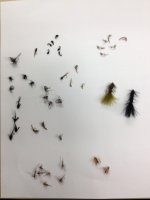sneelhead
New member
new to this fly fishing thing. my trusty PH, HE, and egg patterns stopped working so I did some research and added these to my somewhat growing collection. Nothing out of the ordinary here but thought I'd get some feedback from you guys.
Lets see..from the top; zebra midges, rainbow warriors, a black gnat, little black stones, loop wing BWOs, some quill nymphs, buggers, black PH nymphs, couple quill emergers, grey rs2, BWO soft hackles, black elk hair caddis'
fishing everything wet..i usually fish the pissquest but crowds will prob be stupid this weekend so im going to do some exploring.
basic pointers are much appreciated. i'll prob run one of the larger nymps as a base fly then play with different trailers using all the small stuff. did i miss anything obvious?

Lets see..from the top; zebra midges, rainbow warriors, a black gnat, little black stones, loop wing BWOs, some quill nymphs, buggers, black PH nymphs, couple quill emergers, grey rs2, BWO soft hackles, black elk hair caddis'
fishing everything wet..i usually fish the pissquest but crowds will prob be stupid this weekend so im going to do some exploring.
basic pointers are much appreciated. i'll prob run one of the larger nymps as a base fly then play with different trailers using all the small stuff. did i miss anything obvious?

